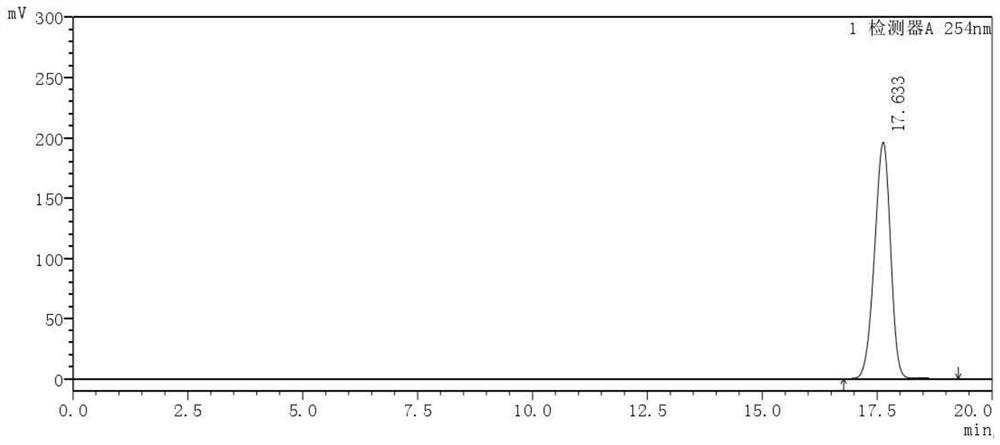A method for enzymatically synthesizing cefaclor
A technology for cefaclor and enzymatic synthesis, which is applied in the field of pharmaceutical and chemical production, and can solve the problems of low enzyme reuse times and insufficient cefaclor purity.
- Summary
- Abstract
- Description
- Claims
- Application Information
AI Technical Summary
Problems solved by technology
Method used
Image
Examples
Embodiment 1
[0041] A method for enzymatic synthesis of cefaclor:
[0042]Step 1. At 10°C, add 60.0 g of 7-amino-3-chloro-cephem acid and 450 mL of mixed solvent to the reaction flask, adjust the pH to 8.1-8.3 with purified ammonia with a mass concentration of 18 wt%, and add immobilized penicillin Acylase 30g, add the side chain mixture of 19g D-p-phenylglycine methyl ester hydrochloride and 31.5g D-phenylglycine methyl ester, react at 20°C for 100min, after the reaction is completed, separate the reaction solution and immobilized cefaclor Synthesize enzyme to obtain the crude cefaclor; wash the immobilized penicillin acylase with 90 mL of the above mixed solution for 3 times, and mix the washing solution with the separated crude cefaclor to obtain the cefaclor crude suspension;
[0043] Wherein, the mixed solvent includes the following components by mass percentage: methanol 3%, glutaraldehyde 0.5%, disodium hydrogen phosphate 0.3%, water 96.2%;
[0044] The way of adding the side chain...
Embodiment 2
[0052] A method for enzymatic synthesis of cefaclor:
[0053] Step 1. At 10°C, add 60.0 g of 7-amino-3-chloro-cephem acid and 550 mL of mixed solvent to the reaction flask, adjust the pH to 8.1-8.3 with purified ammonia with a mass concentration of 20 wt%, and add immobilized penicillin Acylase 15g, add the side chain mixture of 20.2g D-p-phenylglycine methyl ester hydrochloride and 30.6g D-phenylglycine methyl ester at one time, react at 15°C for 150min, after the reaction is completed, separate the reaction solution and fix Cefaclor synthase was synthesized to obtain crude cefaclor; the immobilized penicillin acylase was washed three times with 90 mL of the above mixed solution, and the washing solution was mixed with the separated crude cefaclor to obtain a suspension of cefaclor crude ;
[0054] Wherein, the mixed solvent includes the following components by mass percentage: methanol 0.5%, glutaraldehyde 0.8%, disodium hydrogen phosphate 1%, water 97.7%;
[0055] Step 2,...
Embodiment 3
[0061] A method for enzymatic synthesis of cefaclor:
[0062] Step 1. At 10°C, add 60.0 g of 7-amino-3-chloro-cephelenic acid and 500 mL of mixed solvent to the reaction flask, adjust the pH to 8.1-8.3 with purified ammonia with a mass concentration of 15 wt%, and add immobilized penicillin Acylase 25g, add the side chain mixture of 22g D-p-phenylglycine methyl ester hydrochloride and 29g D-phenylglycine methyl ester, at 25 ° C, react for 80min, after the reaction is completed, separate the reaction solution and immobilize cefaclor to synthesize Enzyme to obtain crude cefaclor; wash the immobilized penicillin acylase with 90 mL of the above mixed solution for 3 times, and mix the washings with the separated crude cefaclor to obtain a suspension of cefaclor crude;
[0063] Wherein, the mixed solvent includes the following components by mass percentage: methanol 10%, glutaraldehyde 1%, disodium hydrogen phosphate 0.1%, water 88.9%;
[0064] The way of adding the side chain mixt...
PUM
 Login to View More
Login to View More Abstract
Description
Claims
Application Information
 Login to View More
Login to View More - R&D
- Intellectual Property
- Life Sciences
- Materials
- Tech Scout
- Unparalleled Data Quality
- Higher Quality Content
- 60% Fewer Hallucinations
Browse by: Latest US Patents, China's latest patents, Technical Efficacy Thesaurus, Application Domain, Technology Topic, Popular Technical Reports.
© 2025 PatSnap. All rights reserved.Legal|Privacy policy|Modern Slavery Act Transparency Statement|Sitemap|About US| Contact US: help@patsnap.com

